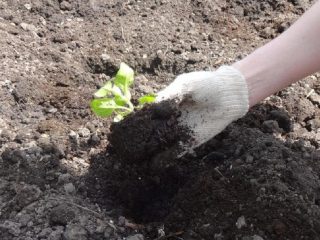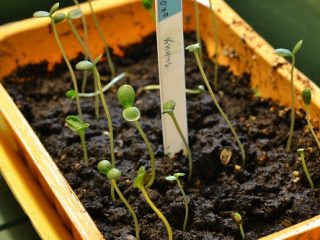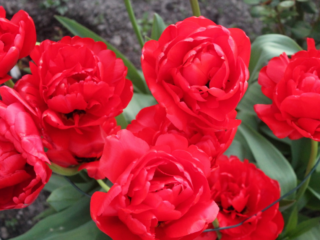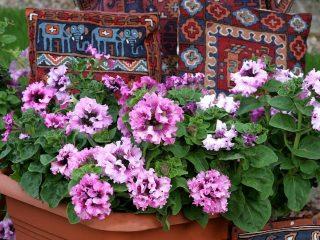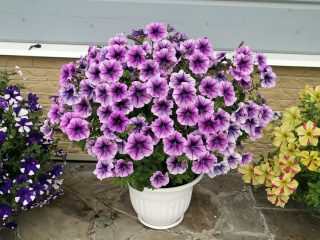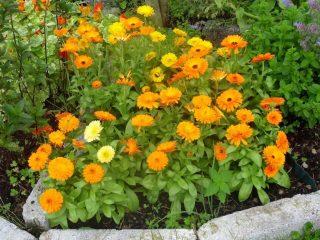Content
Eustoma seedlings do not appear immediately, since the plant is characterized by slow growth. During the development period, it needs to be given attention so that unfavorable factors - poor light, low or high temperature, excessive humidity, drought and other phenomena - do not interfere with cultivation. Failure to comply with agricultural technology leads to a delay in the formation of seedlings.
On what day do eustoma seeds germinate after sowing?
Eustoma seeds in granules germinate 14-16 days after sowing. After five weeks, seedlings can be planted into separate containers. Eustoma seedlings are transferred to the garden three months after this.
What do the first shoots of eustoma look like?
The plant is a perennial, easy to grow both in open ground and at home. Planting material - seeds - are small in size and elongated in shape. Healthy seeds are colored black or brown, depending on the variety.
The photo shows that the first shoots look like small green stems with two leaves.

As they grow, the plates grow up to 80 mm in length
Over time, buds form at the top; they are in a half-open state, which is why they resemble a rose. Flowers can be light pink, snow white, cream, crimson, yellow and blue.
The buds bloom one after another. Each bloom continues for a week. Since up to several flowers can form on one bush, the decorative effect remains for a long period of time.
What determines the germination of eustoma?
The timing of germination of eustoma seeds into seedlings may vary. This depends on many agrotechnical factors. Growing crops is a difficult task. However, if you follow the rules below, even a novice gardener will be able to achieve the appearance of the first healthy shoots.
First of all, you need to take care of the lighting. Before the emergence of seedlings, the eustoma will not have to be illuminated, since there are no green leaves and photosynthesis is not possible. But the pot is still placed on a sunny windowsill. When eustoma shoots form, you will need a phyto- or LED lamp with a natural spectrum. In the early stages of formation, the plant needs good lighting.
Another point that affects germination is planting time. In regions with a temperate climate (which is the entire eastern part of the country), seeds are sown in February or March.
Sowing dates in different areas:
- in the south - during the last winter month;
- in the middle zone - from February 14 to March 5;
- in Siberia - from March 15 to April 5.
You should not rush into planting eustoma: the winter season is considered a dormant period for plants, during which the seeds will not germinate. Even when grown at home, most of the seedlings will not form.

On the other hand, you cannot be late with the deadlines - otherwise the crop will form flowers by autumn
To increase germination, it is recommended to treat eustoma seeds. This is also necessary for preventive purposes, to protect against infections and some pests. Planting material is immersed in a solution of potassium permanganate and left for six hours. After soaking, the raw materials are dried on the windowsill. The window must be open.
Usually eustoma is grown on a windowsill or in a front garden. Moreover, both there and there – like a houseplant. In this regard, beginners forget to take into account the climatic factor - the influence of air. Drafts negatively affect the timing of seedling emergence. If the window sill is narrow, you need to take care that the eustoma leaves do not stick to the window.
In winter, the heating is turned on, which can greatly heat the air. Heating devices must be located at a safe distance from the seedlings.
When growing in a front garden, you need to select a site where the influence of cold winds is minimal and the light is mostly diffused. Eustoma grows well in light shade. At the height of a summer day, the rays should not hit the crop, otherwise burns will occur.
At the moment the first two shoots of eustoma appear, fertilizing must be applied. To do this, use nitrogen or a specialized growth stimulator. Fertilizers are absorbed most quickly in liquid form, so concentrates are combined with water, observing the dosage.
From the beginning of budding, nitrogen is excluded, and potassium and phosphorus are added instead, also in liquid form. Fertilizers are recommended to be used after illness to restore eustoma. If the seedlings are dormant, there is no need to add nutrient mixtures.
Crop rotation works with eustoma. It can be grown in the front garden after any plant previously in the same place. The soil requirements remain the same:
- looseness;
- fertility;
- aeration.
Don't worry if the eustoma hasn't sprouted for 10 days. This is an absolutely normal phenomenon, because seedlings appear in the second week.

There are also varieties with late maturation, for example, Japanese varieties of eustoma form seedlings a month after planting
Why eustoma seeds do not germinate and what to do
The slow growth of eustoma is observed by all gardeners without exception. This always happens when growing indoors. This is due to the long vegetative cycle that the seeds go through from the moment of sowing.
It happens that eustoma does not emerge even after 20-30 days. In this case, it is necessary to treat the crops with Epin or Zircon and pay attention to the following parameters:
- temperature regime;
- soil quality;
- features of planting material;
- humidity;
- excessive depth of seeds.
The temperature regime is violated
Seedlings should be kept at a temperature of +21-25 °C. From the moment the first shoots appear, it is better to move the eustoma to a cooler place, where the temperature is +18 °C during the day and +15 °C at night.The temperature must be constant; this is only possible at home.
Unsuitable soil
To grow eustoma, a light, airy substrate is required. It must have a slightly acidic or neutral reaction. You can collect such soil yourself by taking garden soil, peat and sand in equal proportions. By adding ash, a neutralizing effect is achieved. Before sowing, the soil is calcined in the oven for disinfection. To destroy all bacteria and infections, the optimal treatment time is two hours.
You can purchase nutritional formula at the store. Use substrates marked “for floral and ornamental plants.” They must have neutral acidity.
A good alternative is peat tablets, which include development stimulants. They allow you to wait for seedlings faster. Before planting, peat tablets must be moistened. Their swelling indicates readiness for sowing activities.
Poor quality seeds
Eustoma is a capricious culture. Poor quality planting material may not sprout. Fresh seeds germinate with a probability of 75-80%, and raw materials from two years or more - 35-50%.

That is, every year the germination rate of eustoma drops by an average of 12-20%
Stores sell processed seeds. As a rule, they are coated, that is, they have an additional shell that protects them from adverse conditions. They also increase the size of the seeds, making sowing more convenient.
Eustoma in pellets grows faster.But due to the fact that the raw material is constrained by the shell, it is difficult for the seedlings to hatch on their own - it is necessary to carefully break the seed during the period of seedling formation. This way the plant can stretch.
Growing coated seeds is extra work. If you don’t want to waste extra time, the material is collected from a faded plant. Eustoma must be healthy: free from growths, signs of mechanical damage, weak leaves and stems. Collection should be done carefully - the seeds are quite fragile and can be deformed by careless movement.
Improper watering
Before emergence, the amount of moisture should be controlled. In order not to wash the seeds, watering is carried out using a sprayer. Spraying is done regularly, but not for long. The surface layers are kept moist, while avoiding the formation of puddles.
When the shoots appear, they begin to water the eustoma only after the soil has dried. Excess moisture harms the plant more than drought. In such an environment, fungi form, which suck all the vital energy from the crop.
Burying seeds during planting
For germination, raw materials should not be buried deeply. Normal lighting is necessary for the eustoma to grow. The optimal size of the grooves is 3 mm.
Conclusion
Eustoma shoots appear late compared to other plants. This is due to the slow cycle of cultural development. Sprouts may not appear for more than a month. To prevent this from happening, you need to double-check the temperature, lighting, and amount of moisture.
